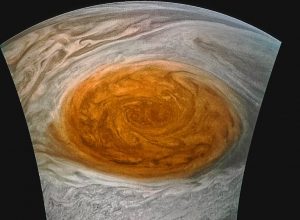The biggest news in space exploration this month has to come from the Juno spacecraft now in orbit around the planet Jupiter. Last Wednesday night Juno made a close approach to Jupiter flying only 3500 kilometers above the planet’s ‘Great Red Spot’ and giving scientists their best look ever at this mysterious object. See the amazing picture below.

The Great Red Spot was first discovered by the British Scientist Robert Hooke around 1650 and has been studied now for over 350 years. Despite all those years of observation the spot’s exact nature is still being debated.
The most popular explanation for the Great Red Spot is that it is a powerful storm, a hurricane larger than the Earth. In fact hurricanes here on Earth can last a very long time so long as they stay over water, only losing their strength when they pass over land.
Still 350 years is a very long time for a storm to last and hurricanes move with the wind patterns while the Great Red Spot appears to be in the same place it was when Hooke first saw it. To me the storm model cannot be a complete description.
Another theory is that the Great Red Spot is something like Jupiter’s version of a volcano, a massive upwelling of gas from deep within the planet. Like the Mona Kea volcano on Hawaii’s big island something inside Jupiter could be continuously erupting and forming the Red Spot around it.
To me it seems that a combination of the two models may be the best solution but in any case hopefully all the data we get back from Juno will give us a greater insight into the nature of The Great Red Spot. If you’d like to read more about Juno, and see some breathtaking images the link below will take you to NASA’s Juno site.
https://www.nasa.gov/mission_pages/juno/main/index.html
Another interesting space news item concerned an experiment by Chinese scientists to teleport a photon, a particle of light, from Earth’s surface to a satellite in orbit. Team leader Ji-Gang Ren of the Department of modern physics at the University of Science and Technology of China along with his colleagues sent the teleported particles from a ground station in Nagari Tibet to the Micius satellite in an orbit 500km above the Earth’s surface. Although not the first successful teleportation experiment this is by far the greatest distance a particle has been teleported.
Recent experiments in teleportation use the phenomenon of ‘Quantum Entanglement’ in order to teleport not so much the actual particle as all the information about it, it’s quantum state in technical terms. For the photons used in the Chinese experiment this information was the polarization of the photons. (I’ll discuss quantum entanglement in another post quite soon)
Now it’s going to be a long time before we are able to transmit the quantum states of Kirk, Spock and Bones so that they can be reassembled on the planet’s surface. However the polarization of a photon can be used as either a 1 or a 0 for the purposes of digitizing information. This is the physics behind the idea of quantum computing that’s getting a lot of talk nowadays.
If you’d like to read more about the Chinese teleportation experiment click on the link below to go to an MIT Technology Review article on it.
https://www.technologyreview.com/s/608252/first-object-teleported-from-earth-to-orbit/
One last item of space news before I go. This past week NASA has kinda, sorta finally admitted that with their current level of funding there is no real chance of a manned mission to Mars by the official target date of 2033. This is hardly a surprise, a manned mission will be hugely expensive and NASA really hasn’t even begun to develop the systems needed.
If you’ve been reading my posts on the subject (Feb 22, 2017) you know that I advocate a return to the Moon with the systems we are currently developing. The Space Launch System and Orion space capsule that will soon be available are perfect for Lunar missions, all that’s needed is a lander module which could be ready in 5-6 years. NASA is not likely to get a large increase in funding anytime soon and really needs to commit itself to a realistic program for manned space exploration!
